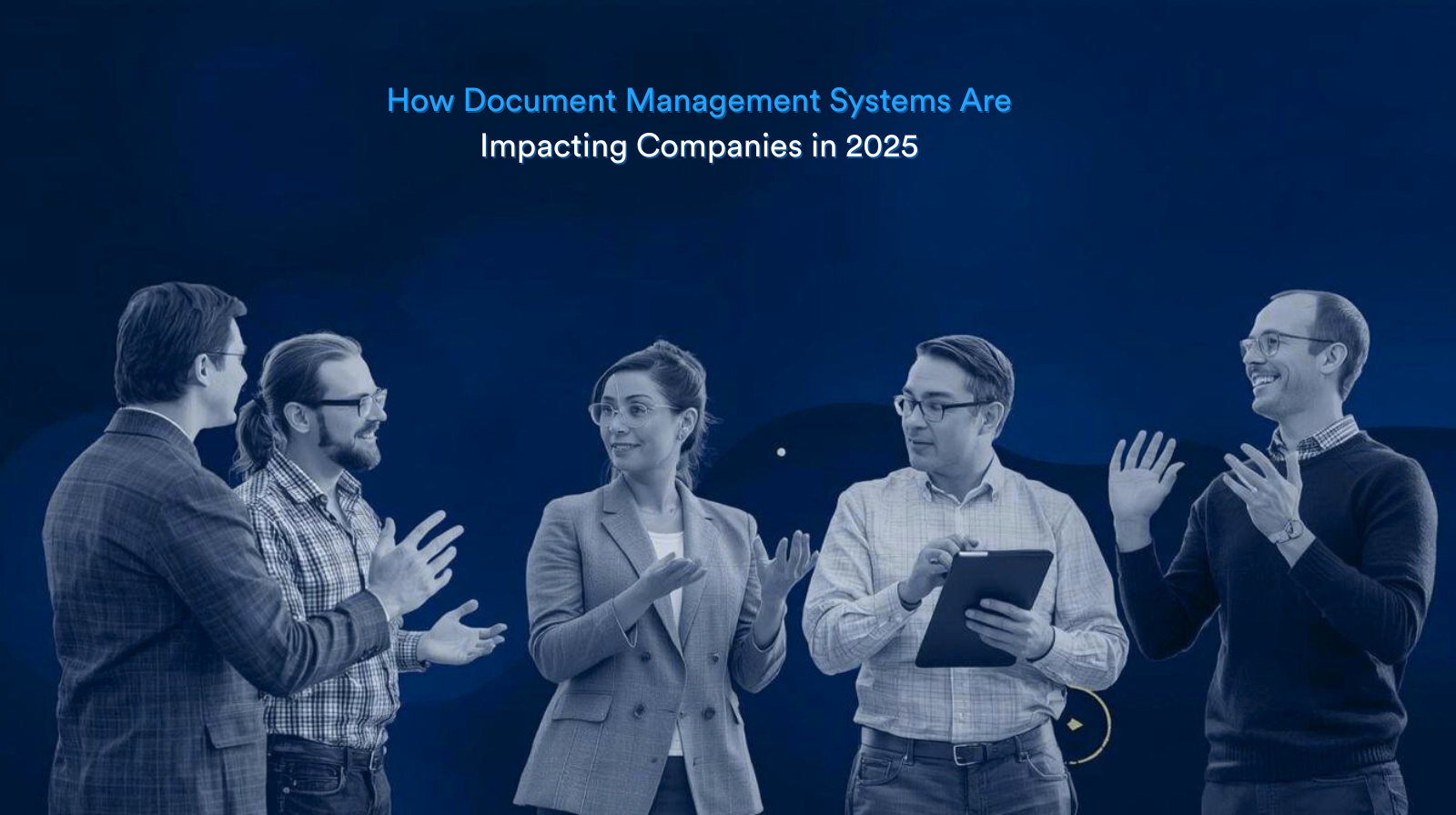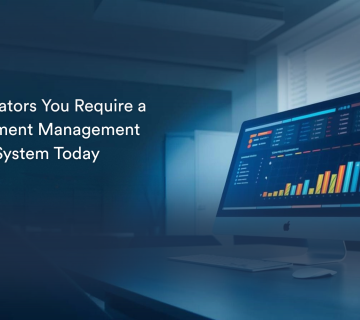Discover how Document Management Systems (DMS) are transforming businesses in 2025. Explore the latest DMS trends, intelligent document management innovations, and how My eOffice empowers a secure, efficient digital workplace with enterprise document software.
Beginning
Businesses are under increasing pressure in 2025 to operate smarter, faster and in a very secure manner. As a response to this, Document Management Systems (DMS) have transformed from simple digital file cabinet solutions into intelligent, integrated platforms that are reinventing how organizations manage their documents. This article discusses the major trends, benefits, challenges and real-life impacts of DMS in the 2025 landscape and what My eOffice can enable you to put yourselves on your front foot by embracing modern document strategies.
What Is a Modern Document Management System?
A Document Management System (DMS) is more than just a repository – it is a solution to allow:
- Centralized storage and version control .
- Automated workflows and routing.
- Metadata tagging, indexing, and intelligent search .
- Access controls, audit tracking, and compliance .
- Integration with other tools (ERP, CRM, email)
The differentiation in a modern DMS is its ability to take advantage of AI, automation, predictive insight, and modular architecture.
Why Are Businesses to Accelerating DMS in 2025
1. Market Momentum & Investment
The global DMS market is expected to reach USD 8.32 billion in 2025, with a compound annual growth rate (CAGR) of 16.6% through 2032 (Fortune Business Insights). This trend reflects a strong enterprise demand for smarter document infrastructure
2. Transition from Cloud-First and Hybrid
Organizations today are adopting either cloud or hybrid deployments as a way to expand globally without significant upfront infrastructure investment in on-premises systems. Cloud DMS allows global access, flexible growth, and lower maintenance of on-premises DMS.
3. Remote & Hybrid Workforce Needs
Teams that require access to documents around the globe require features of infrastructure that provide real-time collaboration on documents, version history, and secure access – DMS is the baseline capability to enable a truly digital office.
4. Growing Security, Privacy & Regulation Expectations
Whether GDPR or a need to comply with regulations specific to their industry demands all companies to implement strict document governance. A DMS with advanced features creates governance by embedding robust role/task-based access control, retention policies, encryption, and audit logs.
5. The Usual Infusion of AI, Automation & Predictive Intelligence
DMS will be more than a place to store documents in 2025. For instance, DMS will leverage AI to automatically tag, classify, route, or even predict document needs, or some anomaly that occurs with the document, for employees.
Key Trends in DMS for 2025
Below are some of the standout trends redefining document management this year:
| Trend | Impact / Use Cases |
| AI-Driven Automation & Document Intelligence | Automatic classification, metadata extraction, anomaly detection, and contextual suggestions. |
| Human-Autonomy Teaming (HAT) | AI co-workers assist with drafting, reviewing, routing, and alerting. |
| Blockchain & Immutable Audit Trails | Tamper-proof logs, digital signatures, smart contracts for high-integrity documents. |
| Headless/Composable Architecture | Decoupling back-end document engines from front-end UIs to embed DMS capabilities into portals, apps, or custom UIs. |
| Tighter Integration with Business Systems | DMS tightly linked to ERP, CRM, HR, project management tools — enabling document workflows across systems. |
| Sustainability & Green Data Centers | Hosting in energy-efficient data centers, reducing paper use, and optimizing storage. |
Benefits That Businesses Gain from a 2025-Style DMS
1. Increased Better Productivity & Time Savings For Employees
Automated workflows, instant access options, and a reduction in errors adds up to employees spending less time on repetitious tasks.
2. Reduced Operating Costs.
Less printing, fewer pieces of physical paper and physical storage space, and a reduction of manual labor for employees allocate to lower overhead, while limiting costs.
3. Improved Document Access for Teams Across Locations
Teams can co-author, comment, and access documents from their location(s) at the same time as other team members.
4. A Stronger Security and Compliance Posture
Robust access control, encryption, versioning, and auditable trails for all transactions makes governance feasible and sustain in a thorough and contemporary manner.
5. Improved Governance & Risk Management
You reduce version discrepancy, unsanctioned alterations, or document disparity.
6. Scalable & Flexible
A new site can scale with the growth of the organization without the costs normally associated with resource-heavy scaling.
7. Data Supported Analysis & Predictive Alerts
DMS analytics may identify barriers, patterns of consumption, or missed documents before they become an issue.
Challenges & Considerations for DMS Implementation in 2025
- Organizational Change & Adoption: Staff may resist the change from an antiquated system
- Migration of Legacy Data: Re-purposing, cleaning, and associating existing file can be labor intensive
- Integration Complexity: Achieving complete interaction with existing ERPs, CRMs, etc.
- Cost & ROI Justification: Planning for the initial investment, monthly or annual fees, and training
- Security Risks: Failure to configure well can lead to leaking data
- Vendor Lock-in: Selecting systems that remain flexible and interoperable
Many of these challenges can be mitigated by responsible objectives, conducting pilot studies, ensuring user training, and phased deployment.
Real Examples & Impact
1. Finance/Accounting
- Automate routing for invoice approvals
- Extract line items and classify expenses
- Complete audit trails for ongoing financial compliance
2. Legal/Contract Management
- Version control of contracts
- Smart alerts for time-sensitive expiry or renewal
- Immutable logs for legal audits
3. Human Resources
- Resume, employee appraisal documents and context for policy
- Role-specific views and restricted access
4. Project & Engineering
- Blueprint, design documents, change logs
- Controlled versioning, collaborative editing
5. Health/Compliance-heavy industries
- Enforce retention schedules, consent documents, regulatory documents
- Tamper-proof audit logs, data anonymization
How My eOffice eDMS can help you take advantage of DMS in 2025
As a platform committed to the efficiency of today’s workplaces, We can provide:
- Consultation on choosing the right DMS model (cloud, hybrid, on-prem)
- Custom integration with your ERP/CRM or other business software
- Data migration and document clean-up support
- Training for teams, and adoption
- Managed–support, security assessments, and optimization
- You can position My eOffice in as a partner to bridge legacy operations to the intelligent document future of 2025.
Conclusion
In 2025, Document Management Systems are more than ‘just ‘digital filing systems. They are intelligent, automated, and security-focused platforms that alter the way business create, manage and secure information.
Organizations that embrace modern DMS receive agility, compliance, and insight – and with partnerships like My eOffice can be less manual and more strategic.





No comment